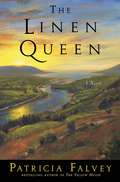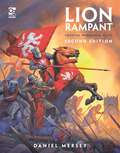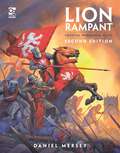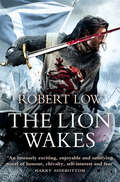- Table View
- List View
The Limits of Safety: Organizations, Accidents, and Nuclear Weapons (Princeton Studies in International History and Politics #177)
by Scott Douglas SaganEnvironmental tragedies such as Chernobyl and the Exxon Valdez remind us that catastrophic accidents are always possible in a world full of hazardous technologies. Yet, the apparently excellent safety record with nuclear weapons has led scholars, policy-makers, and the public alike to believe that nuclear arsenals can serve as a secure deterrent for the foreseeable future. In this provocative book, Scott Sagan challenges such optimism. Sagan's research into formerly classified archives penetrates the veil of safety that has surrounded U.S. nuclear weapons and reveals a hidden history of frightening "close calls" to disaster.
The Limits of Sino-Russian Strategic Partnership (Adelphi series)
by Jennifer AndersonRussia and China claim to have established a "strategic partnership". Jennifer Anderson argues that this relationship merely overlays a diplomatic agenda established in the late 1980s, and that China's pragmatic, limited approach (coupled with Russia's domestic economic and political difficulties) have meant that the Sino-Russian strategic partnership is unwieldy and imprecise.
The Limits of Sino-Russian Strategic Partnership (Adelphi series)
by Jennifer AndersonRussia and China claim to have established a "strategic partnership". Jennifer Anderson argues that this relationship merely overlays a diplomatic agenda established in the late 1980s, and that China's pragmatic, limited approach (coupled with Russia's domestic economic and political difficulties) have meant that the Sino-Russian strategic partnership is unwieldy and imprecise.
Lincoln and His Admirals
by Craig SymondsAbraham Lincoln began his presidency admitting that he knew "but little of ships," but he quickly came to preside over the largest national armada to that time, not eclipsed until World War I. Written by naval historian Craig L. Symonds, Lincoln and His Admirals unveils an aspect of Lincoln's presidency unexamined by historians until now, revealing how he managed the men who ran the naval side of the Civil War, and how the activities of the Union Navy ultimately affected the course of history. Beginning with a gripping account of the attempt to re-supply Fort Sumter--a comedy of errors that shows all too clearly the fledgling president's inexperience--Symonds traces Lincoln's steady growth as a wartime commander-in-chief. Absent a Secretary of Defense, he would eventually become de facto commander of joint operations along the coast and on the rivers. That involved dealing with the men who ran the Navy: the loyal but often cranky Navy Secretary Gideon Welles, the quiet and reliable David G. Farragut, the flamboyant and unpredictable Charles Wilkes, the ambitious ordnance expert John Dahlgren, the well-connected Samuel Phillips Lee, and the self-promoting and gregarious David Dixon Porter. Lincoln was remarkably patient; he often postponed critical decisions until the momentum of events made the consequences of those decisions evident. But Symonds also shows that Lincoln could act decisively. Disappointed by the lethargy of his senior naval officers on the scene, he stepped in and personally directed an amphibious assault on the Virginia coast, a successful operation that led to the capture of Norfolk. The man who knew "but little of ships" had transformed himself into one of the greatest naval strategists of his age. Co-winner of the 2009 Lincoln Prize Winner of the 2009 Barondess/Lincoln Prize by the Civil War Round Table of New York John Lyman Award of the North American Society for Oceanic History Daniel and Marilyn Laney Prize by the Austin Civil War Round Table Nevins-Freeman Prize of the Civil War Round Table of Chicago
Lincoln and His Admirals
by Craig SymondsAbraham Lincoln began his presidency admitting that he knew "but little of ships," but he quickly came to preside over the largest national armada to that time, not eclipsed until World War I. Written by naval historian Craig L. Symonds, Lincoln and His Admirals unveils an aspect of Lincoln's presidency unexamined by historians until now, revealing how he managed the men who ran the naval side of the Civil War, and how the activities of the Union Navy ultimately affected the course of history. Beginning with a gripping account of the attempt to re-supply Fort Sumter--a comedy of errors that shows all too clearly the fledgling president's inexperience--Symonds traces Lincoln's steady growth as a wartime commander-in-chief. Absent a Secretary of Defense, he would eventually become de facto commander of joint operations along the coast and on the rivers. That involved dealing with the men who ran the Navy: the loyal but often cranky Navy Secretary Gideon Welles, the quiet and reliable David G. Farragut, the flamboyant and unpredictable Charles Wilkes, the ambitious ordnance expert John Dahlgren, the well-connected Samuel Phillips Lee, and the self-promoting and gregarious David Dixon Porter. Lincoln was remarkably patient; he often postponed critical decisions until the momentum of events made the consequences of those decisions evident. But Symonds also shows that Lincoln could act decisively. Disappointed by the lethargy of his senior naval officers on the scene, he stepped in and personally directed an amphibious assault on the Virginia coast, a successful operation that led to the capture of Norfolk. The man who knew "but little of ships" had transformed himself into one of the greatest naval strategists of his age. Co-winner of the 2009 Lincoln Prize Winner of the 2009 Barondess/Lincoln Prize by the Civil War Round Table of New York John Lyman Award of the North American Society for Oceanic History Daniel and Marilyn Laney Prize by the Austin Civil War Round Table Nevins-Freeman Prize of the Civil War Round Table of Chicago
Lincoln’s 90-Day Volunteers 1861: From Fort Sumter to First Bull Run (Men-at-Arms)
by Adam Hook Ron FieldOn April 15th 1861, the day after the fall of Fort Sumter, President Abraham Lincoln issued a call for 75,000 volunteers to enlist for three months' service to defend the Union. This 90-day period proved entirely unrealistic and was followed by further, and much more extensive, mobilizations. Despite this, for the first few months the defence of the Capitol depended heavily on a hastily gathered, but extremely loyal, army of militiamen and volunteers. Mostly inexperienced, poorly trained, weakly officered, and provided with motley uniforms, equipment and weapons, they bought the Union time during the vital first months. Through a wide range of period sources, this title describes and illustrates the actual appearance of this diverse and colorful force, including photographs, eyewitness accounts in period newspapers and letters, the reports of government agents, and the records of the many manufacturers who received orders to clothe and equip their state troops.
Lincoln’s 90-Day Volunteers 1861: From Fort Sumter to First Bull Run (Men-at-Arms #489)
by Adam Hook Ron FieldOn April 15th 1861, the day after the fall of Fort Sumter, President Abraham Lincoln issued a call for 75,000 volunteers to enlist for three months' service to defend the Union. This 90-day period proved entirely unrealistic and was followed by further, and much more extensive, mobilizations. Despite this, for the first few months the defence of the Capitol depended heavily on a hastily gathered, but extremely loyal, army of militiamen and volunteers. Mostly inexperienced, poorly trained, weakly officered, and provided with motley uniforms, equipment and weapons, they bought the Union time during the vital first months. Through a wide range of period sources, this title describes and illustrates the actual appearance of this diverse and colorful force, including photographs, eyewitness accounts in period newspapers and letters, the reports of government agents, and the records of the many manufacturers who received orders to clothe and equip their state troops.
Lindell's List: Saving British and American Women at Ravensbrück
by Peter HoreAlready a decorated heroine of the First World War, British-born Mary Lindell, Comtesse de Milleville, was one of the most colourful and courageous agents of the Second World War, yet her story has almost been forgotten. Evoking the spirit of Edith Cavell, and taking the German occupation of Paris in 1940 as a personal affront, she led an escape line for patriotic Frenchmen and British soldiers. After imprisonment, escape to England, a secret return to France and another arrest, she began to witness the horrors of German-run prisons and concentration camps. In April 1945, a score of British and American women emerged from the Women’s Hell – Ravensbrück concentration camp – who had been kept alive by the willpower and the strength of one woman, Mary Lindell. She combined a passion for adventure with blunt speech and persistently displayed the greatest personal bravery in the face of great adversity. To counter German claims that they had no British or American prisoners, Mary smuggled out a plea for rescue and produced her list from her pinafore pocket, compiled in secret from the camp records. This vital list contained the names of captured women, many of whom were agents of British Military Intelligence, the Special Operations Executive or the French Resistance. Poignantly supported by first-hand testimony, Lindell’s List tells the moving story of Mary Lindell’s heroic leadership and the endurance of a group of women who defied the Nazis in the Second World War.
A Line in the Sand: A Novel
by Kevin PowersFROM THE AWARD-WINNING AUTHOR OF THE YELLOW BIRDS'Entertaining, intelligent, and effortlessly readable' Sunday Times'A stunning novel' New York Times'One of the best crime novels of the year' Irish Times'A cracking mystery' Guardian'Tense and enthralling' Daily Mail'Taut and enjoyable' Daily Telegraph'A kickass mystery from a superb storyteller' David Baldacci, author of The 6:20 Man'A spellbinding and totally original thriller' Philipp Meyer, author of The Son An early morning on a beach in Virginia. As he is taking his daily swim, Arman Bajalan - formerly an interpreter in Iraq - discovers a dead body. After surviving an assassination attempt that killed his wife and child, Arman has been given lonely sanctuary in the US. Now, sure that the murder is connected to his past, he knows he's still not safe.Seasoned detective Catherine Wheel and her fresh-off-the-beat partner have little to go on beyond a bus ticket in the man's pocket. It leads them to Sally Ewell, a local journalist as grief-stricken as Arman by the Iraq war, who is investigating a nefarious corporation: one on the cusp of landing a multi-billion-dollar government defence contract.As victims mount around Arman, taking the team down wrong turns and towards startling evidence, they find themselves in a race, committed to unravelling the truth and keeping Arman alive - even if it costs them everything.A Line in the Sand is a sinuous, powerful and white-knuckle thriller, from the award-winning author of The Yellow Birds, shot through with treachery, trauma and the long tentacles of war.
Line of Control A Thriller on the Coming War in Asia: A Thriller On The Coming War In Asia
by Mainak DharIt is 2012, and the world is a more dangerous place than ever before. Revolutions have swept aside one Middle Eastern regime after another. A regime allied to Al Qaeda has swept to power in Saudi Arabia, and uses its oil wealth and modern arsenal to further spread Jihad around the world. Yet another military coup brings a fundamentalist regime to power in Pakistan, which initiates an audacious plan to strike the first blow in this new global Jihad. As unprecedented terror attacks stun India, the stage is set for a conflict that brings the Indian subcontinent to the brink of a nuclear annihilation.
Line Of Honor
by Don PendletonA group of American medics and dozens of refugees are held captive after a Janjaweed war band takes control of their camp in Darfur. With the president's hands bound by political red tape, Mack Bolan launches a rescue mission using his own team of mercenaries.
The Linen Queen: A Novel
by Patricia FalveyAbandoned by her father and neglected by her self-centered, unstable mother, Sheila McGee cannot wait to escape the drudgery of her mill village life in Northern Ireland. Her classic Irish beauty helps her win the 1941 Linen Queen competition, and the prize money that goes with it finally gives her the opportunity she's been dreaming of. But Sheila does not count on the impact of the Belfast blitz which brings World War II to her doorstep. Now even her good looks are useless in the face of travel restrictions, and her earlier resolve is eroded by her ma's fear of being left alone.When American troops set up base in her village, some see them as occupiers but Sheila sees them as saviors--one of them may be her ticket out. Despite objections from her childhood friend, Gavin O'Rourke, she sets her sights on an attractive Jewish-American army officer named Joel Solomon, but her plans are interrupted by the arrival of a street-wise young evacuee from Belfast.Frustrated, Sheila fights to hold on to her dream but slowly her priorities change as the people of Northern Ireland put old divisions aside and bond together in a common purpose to fight the Germans. Sheila's affection for Joel grows as she and Gavin are driven farther apart. As the war moves steadily closer to those she has grown to love, Sheila confronts more abandonment and loss, and finds true strength, compassion, and a meaning for life outside of herself.
The Lines of Torres Vedras 1809–11 (Fortress)
by Bill Younghusband Ian FletcherFollowing the battle of Bussaco on 27 September 1810 Wellington's heavily outnumbered troops began to withdraw towards Lisbon. By the evening of 9 October the British and Portuguese began to withdraw behind a line of defensive works that had been built to the north of Lisbon. These were not the rudimentary field works that the French anticipated, but an enormous network of forts, batteries and redoubts whose construction had been started the previous November the Lines of Torres Vedras. This 30-mile-wide line utilised the area's natural defences, damming rivers, scarping hillsides, blocking roads and establishing forts upon almost all of the hills. This title describes its design, creation and effectiveness in the face of French attacks.
The Lines of Torres Vedras 1809–11 (Fortress #7)
by Bill Younghusband Ian FletcherFollowing the battle of Bussaco on 27 September 1810 Wellington's heavily outnumbered troops began to withdraw towards Lisbon. By the evening of 9 October the British and Portuguese began to withdraw behind a line of defensive works that had been built to the north of Lisbon. These were not the rudimentary field works that the French anticipated, but an enormous network of forts, batteries and redoubts whose construction had been started the previous November the Lines of Torres Vedras. This 30-mile-wide line utilised the area's natural defences, damming rivers, scarping hillsides, blocking roads and establishing forts upon almost all of the hills. This title describes its design, creation and effectiveness in the face of French attacks.
Lingua Franca and Français Tirailleur: From Sea Jargon to Military Order?
by Joanna NolanThis book explores how the eponymous and original Lingua Franca was recognized as a potential linguistic template for future military and colonial pidgins. The author traces the career trajectory of General Louis Faidherbe, a member of the French colonizing force in Algiers in the early 1830s and a recognized linguist, who rose up through the ranks in various African colonies and was the founder of regiments in West Africa, including the Senegal-based tirailleurs. Their artificially constructed military pidgin, Français Tirailleur, was a language modelled on the reduced grammar and lexicon of Lingua Franca. This book demonstrates the direct link between the two languages, as well as connections with other colonial pidgins in Asia that also derived to some extent from Lingua Franca. It will be of interest to students and scholars of language contact and language history, pidgins and creoles, and military and colonial history.
Lion: 'Brings war in the ancient world to vivid, gritty and bloody life' ANTHONY RICHES
by Conn IgguldenEXPERIENCE THE EPIC BATTLEFIELDS OF ANCIENT GREECE WITH MASTER STORYTELLER CONN IGGULDEN'Pacy and propulsive . . . Crackling with energy, violence and stirring speeches, Lion chronicles power struggles, political machinations and the bloodthirsty ravages of up-close combat' DAILY MAIL'Iggulden draws the Greek world convincingly and he is strongest writing battle scenes' THE TIMESTHE FIRST BOOK IN CONN IGGULDEN'S EPIC NEW SERIES THE GOLDEN AGE_______Ancient Greece, 5th century BCThe age of myths and legends has given way to the world of men. In the front rank stands Pericles, Lion of Athens.Behind Pericles lies the greatest city of the ancient world. Before him, on land and at sea, stands the merciless Persian army. Both sides are spoiling for war.Though still a young man, Pericles knows one thing: to fight a war you must first win the peace.It's time for a hero to rise.For his enemies to tremble.And for Athens, a city of wisdom and warriors, to shine with glory . . ._______PRAISE FOR CONN IGGULDEN:'Brings war in the ancient world to vivid, gritty and bloody life' ANTHONY RICHES'Another masterpiece from Iggulden' 5***** Reader Review'It's like being on the battlefield' 5***** Reader Review'An epic piece of historical fiction, full of political intrigue and vivid action' ROBERT FABBRI
The Lion Above the Door
by Onjali Q. RaufFrom Onjali Q. Rauf, the award-winning and best-selling author of The Boy at the Back of the Class, comes an incredible story about missing histories and the concept of a universal family, told with humour and heart.Leo and his best friend Sangeeta are the odd ones out in their school. But as Leo's dad is always telling him, it's because they're special. Only thing is, if they're so special, how come they never see anyone who looks like them in their school history books?Then, on a class trip to a nearby cathedral, Leo's attention is drawn to a large marble slab high above the doors of the hall. Right there, bang in the middle of a list of war heroes, Leo finds himself staring at something incredible: his own name.Desperate to know who this other Leo was, the two friends embark on a search. And together, they begin to uncover missing stories from the past, ones which they are determined to put back into their rightful place in the pages of history.Touching on themes of historical racism, The Lion Above the Door shines a light on the stories our history books have yet to contain and the power of friendships that can last through generations.The first edition of this book also contains a special collection of historical photos and stories of real life forgotten heroes from World War Two.
The Lion at Dawn: Forging British Strategy In the Age of the French Revolution, 1783-1797 (Campaigns and Commanders #75)
by Nathaniel JarrettIn February 1793, in the wake of the War of American Independence and one year after British prime minister William Pitt the Younger had predicted fifteen years of peace, the National Convention of Revolutionary France declared war on Great Britain and the Netherlands. France thus initiated nearly a quarter century of armed conflict with Britain. During this fraught and still-contested period, historian Nathaniel Jarrett suggests, Pitt and his ministers forged a diplomatic policy and military strategy that envisioned an international system anticipating the Vienna settlement of 1815. Examining Pitt’s foreign policy from 1783 to 1797—the years before and during the War of the First Coalition against Revolutionary France—Jarrett considers a question that has long vexed historians: Did Pitt adhere to the “blue water” school, imagining a globe-trotting navy, or did he favor engagement nearer to shore and on the European Continent? And was this approach grounded in precedent, or was it something new? While acknowledging the complexities within this dichotomy, The Lion at Dawn argues that the prime minister consistently subordinated colonial to continental concerns and pursued a new vision rather than merely honoring past glories. Deliberately, not simply in reaction to the French Revolution, Pitt developed and pursued a grand strategy that sought British security through a novel collective European system—one ultimately realized by his successors in 1815. The Lion at Dawn opens a critical new perspective on the emergence of modern Britain and its empire and on its early effort to create a stable and peaceful international system, an ideal debated to this day.
The Lion of Mistra: A rich tale of clashing empires (Rise of Empires #3)
by James Heneage'One hell of a fine book' Conn IgguldenROME NEVER FELL. IT BECAME BYZANTIUM.AS OTTOMAN FORCES INVADE, ONE MAN MUST DEFEND HIS COUNTRY AND FACE HIS OWN PERSONAL DESTINY...A rich tale of clashing empires and trade wars, lost treasure and tempestuous love in an age when the fate of the world hung on the survival of Byzantium, the hinge between east and west. Luke Magoris, a descendant of the princes of England, is a man with a rare talent for war and trade. To him falls the overwhelming task of defending his beloved Mistra against the rampant Ottoman forces.
Lion Rampant
by Bernard KnightA historical epic by Bernard Knight, Lion Rampant is set in medieval Wales and features the tale of Nest, a princess known as 'the Welsh Helen of Troy'. Nest was a lover of King Henry I of England, married the steward of a Pembrokeshire castle (giving rise to the FitzStephen and FitzGerald families, including Gerald of Wales), and was later abducted by a marauding Welsh noble. This is the story of the adventure, intrigue, and warfare in the various kingdoms of Wales during the twelfth century.
The Lion Rampant: The Lion Wakes, The Lion At Bay, The Lion Rampant (The Kingdom Series)
by Robert LowThe third book in Robert Low’s stunning new trilogy about the making of Scotland.
Lion Rampant: Medieval Wargaming Rules
by Daniel MerseyAn expanded edition of the Origins Award-nominated Lion Rampant, featuring new rules, scenarios, and sample armies.Take to the battlefield as Richard the Lionheart, Joan of Arc or William Wallace – or forge your own legend – with Lion Rampant: Second Edition. From the Dark Ages to the Hundred Years' War, raids, skirmishes, and clashes between small retinues were a crucial part of warfare, and these dramatic small-scale battles are at the heart of this easy-to-learn but tactically rewarding wargame. Lion Rampant: Second Edition is a new, updated version of the hit Osprey Wargames series title, and retains the core gameplay while also incorporating a wealth of new rules and updates from several years' worth of player feedback and development. Whether they are looking to recreate historical encounters or tell their own stories, the varied scenarios, unit types, and sample retinue lists found in this volume provide everything players need to face each other in quick, exciting, and, above all, fun tabletop battles.
Lion Rampant: Medieval Wargaming Rules
by Daniel MerseyAn expanded edition of the Origins Award-nominated Lion Rampant, featuring new rules, scenarios, and sample armies.Take to the battlefield as Richard the Lionheart, Joan of Arc or William Wallace – or forge your own legend – with Lion Rampant: Second Edition. From the Dark Ages to the Hundred Years' War, raids, skirmishes, and clashes between small retinues were a crucial part of warfare, and these dramatic small-scale battles are at the heart of this easy-to-learn but tactically rewarding wargame. Lion Rampant: Second Edition is a new, updated version of the hit Osprey Wargames series title, and retains the core gameplay while also incorporating a wealth of new rules and updates from several years' worth of player feedback and development. Whether they are looking to recreate historical encounters or tell their own stories, the varied scenarios, unit types, and sample retinue lists found in this volume provide everything players need to face each other in quick, exciting, and, above all, fun tabletop battles.
Lion Rampant: Medieval Wargaming Rules (Osprey Wargames)
by Daniel Mersey Mark StaceyTake Robin Hood, Richard the Lionheart, Gamelyn, William Wallace and other legends from the colourful, dangerous medieval period to the tabletop with Lion Rampant – a new set of rules designed for fighting medieval skirmish games. Ideal for players who wish to collect medieval miniatures and paint the pageantry without wanting to muster huge forces or spend time learning complex rules, this game allows players to game actual historical battles – or to delve into the archives of Hollywood to embark on more over-the-top pulp style clashes.
The Lion Wakes: The Lion Wakes, The Lion At Bay, The Lion Rampant (The Kingdom Series)
by Robert LowThe first novel in The Kingdom Series as Robert Low moves from the Vikings to the making of Scotland.























